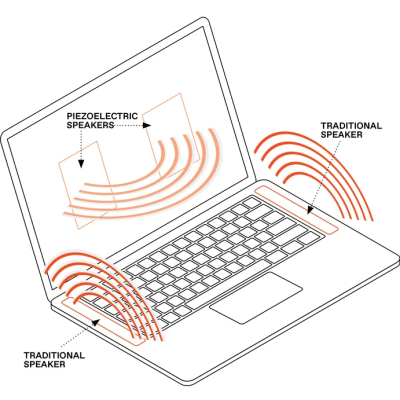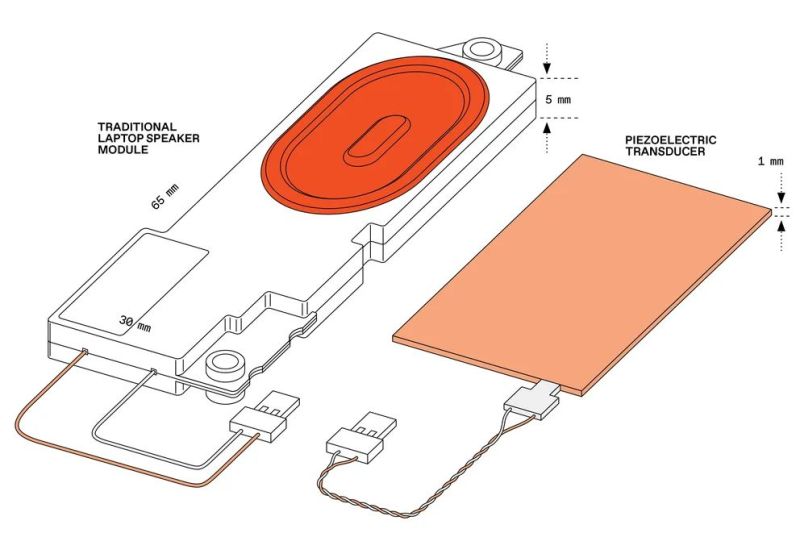Will piezoelectric-based speakers replace traditional speakers over the coming years in space-constrained devices? We have definitely seen the use of piezo transducers in e.g. high-end televisions that use the display’s surface not just for the visual content, but also as a highly dynamic speaker. If you extrapolate this principle to something like smartphones, tablets and laptops the advantages are clear: piezoelectric transducers are smaller, more power efficient and do not need any holes in the enclosure. These and other advantages are what [Vineet Ganju] argues in IEEE Spectrum will push the market to adopt this new technology.

[Vineet] is the Vice President and General Manager of the audio business unit of Synaptics — which is one of the companies pushing for these piezoelectric transducers to be used for speaker purposes — so there is definitely some bias involved. Even so, it’s undeniable that the speakers in portable devices as well as the average flat panel TV aren’t exactly amazing, with the limited space meaning that audio quality suffers, with lows being generally absent and the resulting audio sounding ‘tinny’. Generally this is where people get external speakers for their TV, and lug portable speakers along with their laptop and other mobile devices.
For TVs, Sony has pushed for its Acoustic Surface Audio technology that uses two or three piezoelectric transducers on their OLED panels, while Samsung sticks to traditional speakers, but places lots of them around the screen with its Object Tracking Sound technology.
Sony’s technology cannot be used with LCD panels, due to the backlight being in the way, so the interesting question here is whether the piezoelectric speaker revolution proposed by [Vineet] will be limited to devices that use OLED or similar backlight-less displays?

















It’s not too different from theaters putting speakers behind the screen.
It is completely different from theaters putting speakers behind the screen. Screen in theaters is just a fabric that lets sound pass trough, and speakers behind it are traditional boxes. This uses piezoelectric transducers that turns laptop display surface into active sound emitting device.
ehhmmm… it is very different
Why bother? Speakers in laptops are waste of space anyway, just remove them. Sound is crappy, on the go you can use headphones, at home you can attach decent speakers, and most importantly in public space you are annoying everyone around you if you use them. Same with speakers in phones.
I am very impressed at the sound on new MacBooks. Surprisingly full and deep with really good stereo separation- Apple must be doing some DSP magic.
Even some phones can be perfectly decent for what they are, if you prop them up to avoid resonances and you make sure the EQ is conservative.
So you’ve never put someone or something on speaker so that multiple people could hear at once?
Some people have never had any friends.
I did. But I try to avoid that in public space, I try to be considerate to other people.
Good, but you’re leaving out the chance of not having your speakers with you while still having no-one around to disturb. I often put a phone on speaker just so I can have my hands free even in perfect privacy, and then take it back off of speaker once I’m done. I don’t want to need to plug in or pair a speaker I separately carried in my pocket for some reason. And no reason for a laptop to be unable to fit what a phone can fit.
“Why bother? Trackpads in laptops are waste of space anyway, just remove them. They’re slow, difficult to use, at home you can attach a wireless mouse and more importantly in public space you are annoying everyone around you if you use them. Same with touchscreens in phones.”
That is what you sound like. The removal of a standard feature of mobile computing devices that has been around for at least four decades, does not resolve the social etiquette problem.
Public shaming does. So go on, shame those people who listen to their music or zoom calls in public.
Neat new attack vector: Find the resonant frequency of that display glass…
Listening to Opera will therefore break all screens at some point.
Live or Memorex.
Link it with this and see what can be done! lol
https://hackaday.com/2020/01/31/a-60-ghz-phased-array/
Does it actually have bass? They mention that existing piezoelectrics don’t have good low-end, but they don’t mention if they actually improve low-end. I’m hoping for improved small speakers, not smaller yet still-crappy speakers.
Beat (frequency) could improve the base by generating two or more tones in the ultrasonic range. But the maths would be complex.
Thats basically a phased array, and the math would be complex, but its also a solved problem.
You know those transducers that you put on a windowpane or a table? The bass comes through because of the large surface area.
So will there be tiny gaps in the frequency response of the speakers to avoid resonance damage to the device. Or is this part of planed obelanence where the hardware selfdestructs shortly after the warranty expires.
Every day we take one step closer to the telescreen;)
LG did something similar in 2019 but the sound was probably subpar: https://www.lgnewsroom.com/2019/02/lg-continues-to-push-boundaries-of-exceptional-smartphone-audio-with-new-g-series/
LG did something similar in 2019 but the sound was probably subpar: https://www.lgnewsroom.com/2019/02/lg-continues-to-push-boundaries-of-exceptional-smartphone-audio-with-new-g-series/
NXT apparently did their flat speakers back in 1999. I *vaguely* remember something about them doing screens as part of the screen: https://journalrecord.com/1999/03/nxt-develops-seethrough-speaker/
Laptop manufacturers are either a)utterly clueless or b) taking the piss.
My Asus RoG Zephyrus sounds nowhere near as good (or loud) as my Black Shark 5. It can’t even match my ancient MotoX.
There’s absolutely no reason that a laptop couldn’t have L, R, C and a little subwoofer underneath (well, that’s what my Vernier reckons).
Introducing nonsense technology when there’s excellent, cheap and readily available kit out there makes me sneer not spend.
My Asus ROG Zephyrus has much better sound than my HP Victus. And both are superior to every smartphone and tablet in the house. It’s all relative really. The Asus has better quality sound than a pair of 4″ bookshelf speakers from Edifier, but lower volume of course. And I’m not suggesting Asus laptops are high-end or hi-fi or anything, it’s just that a majority of stuff has really bad quality audio.
I have a Bose Soundlink mini 2 as well. It’s OK. It’s impressive for the size, but objectively the sound quality is not great. It suffers from the small speaker trying to do bass problem. It’s like you get the overtones and harmonics of a big bass without the actual bass frequencies. (like “bass boost” on a walkman)
When portability and size isn’t an issue the problem of decent quality audio is trivial and relatively inexpensive to solve. An amplier, a pair of 2-way or 3-way speakers (or four speakers). And a sub-woofer (doesn’t have to be all that big). Generally powered speakers are over priced for what you get. A lot of companies make a good mid-level quality unpowered speaker, but an amplifier/receiver cost can spiral out of control if you are sensitive to features.
These small devices have to make so many compromises in their audio system which jacks up the cost or dramatically compromises the sound quality. I can’t really recommend any of them except in desperation (obviously I want to listen to youtube and netflix with my wife rather than restricting myself to silent films)
One of my old laptops has 2.1 – https://www.notebookcheck.net/Review-Eurocom-Racer-3W-Clevo-P151SM-Notebook.109795.0.html
and I was impressed when I first tried it but time moved on (although laptop manufacturers obviously didn’t).
https://www.dxomark.com/smartphones/#sort-audio/device- shows phone test results. Unfortunately, they don’t go back far enough to show the Moto X but basically, 9 years after it’s release, it still sounds much better than the majority of “flagships” currently on the market. I replaced it with the Razer 2, Black Shark 3, BS4 then BS5 and, when a much better sounding phone comes along, I’ll be buying that.
A laptop with three Black Shark speakers and a subwoofer isn’t Star Trek tech; it’s doable right now, not expensive to implement and there’s no reason, I can see, that it hasn’t been done.
If Black Shark released a laptop, I’d be all over it!
Until it’s thin as all get out it can’t move air without a big impedance mismatch, maybe with a horn in front of it. Then it has to move itself not another bigger mass, a tweeter at most.
If you try to make sound come out of some mass it has to vibrate intensely compared to a stiff paper or plastic form.
Will we have to place our devices on an empty cardboard box or a grand piano soundboard to hear them?